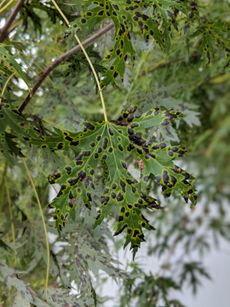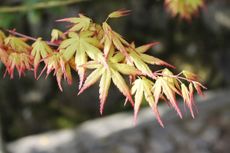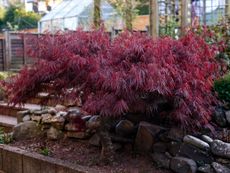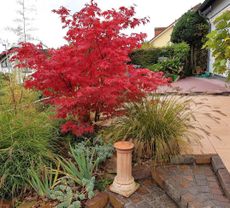Japanese Maple Grafting: Can You Graft Japanese Maples


Can you graft Japanese maples? Yes, you can. Grafting is the primary method of reproducing these beautiful and much-admired trees. Read on to learn about how to graft a Japanese maple rootstock.
Japanese Maple Grafting
Most Japanese maples sold commercially have been grafted. Grafting is a very old method of reproducing plants, especially those that are difficult to grow from seed and cuttings. Japanese maples fall into this category. Growing Japanese maple cultivars from seed is difficult since the tree’s flowers openly pollinate, this means that they accept pollen from most other maples in the area. Given this, you can never be certain that the resulting seedling will have the same looks and qualities as the desired cultivar. Regarding growing Japanese maple from cuttings, many species simply cannot be grown this way. Other species are simply very difficult. For these reasons, the propagation method of choice for Japanese maples is grafting.
Grafting Japanese Maple Rootstock
The art of Japanese maple grafting involves melding – growing together – two closely related species. The roots and trunk of one type of Japanese maple are placed together with the branches and foliage of another to form one tree. Both the rootstock (the lower section) and the scion (the upper part) are carefully chosen. For the rootstock, pick a vigorous species of Japanese maple that rapidly forms a strong root system. For the scion, use a cutting from the cultivar you wish to propagate. The two are carefully joined and allowed to grow together. Once the two have grown together, they form one tree. After that, the care of grafted Japanese maples is very similar to the care of seedling Japanese maples.
How to Graft a Japanese Maple Tree
The procedure for joining the rootstock and the scion is not difficult, but many factors can influence the success of the venture. These include season, temperature, and timing. Experts recommend grafting a Japanese maple rootstock in winter, with January and February being the preferred months. The rootstock is usually a seedling that you have grown for a few years before the grafting. The trunk must have a diameter of at least 1/8 inch (3 mm.). Move the dormant rootstock plant into the greenhouse a month before the grafting to bring it out of dormancy. On the day of the grafting, take a cutting of about the same trunk diameter from the cultivar plant you wish to reproduce. Many different types of cuts can be used for Japanese maple grafting. One simple one is termed the splice graft. To make the splice graft, cut off the top of the rootstock trunk in a long diagonal, about an inch (2.5 cm.) long. Make the same cut at the base of the scion. Fit the two together and wrap the union with a rubber grafting strip. Secure the graft with grafting wax.
Care of Grafted Japanese Maples
Give the plant just a little water at infrequent intervals until the grafted sections grow together. Too much water or too frequent irrigation can drown the rootstock. After the graft heals, remove the grafting strip. From that time on, the care of grafted Japanese maples is very much like the care of plants grown from seeds. Prune off any branches that appear below the graft.
Gardening tips, videos, info and more delivered right to your inbox!
Sign up for the Gardening Know How newsletter today and receive a free download of our most popular eBook "How to Grow Delicious Tomatoes."

Teo Spengler has been gardening for 30 years. She is a docent at the San Francisco Botanical Garden. Her passion is trees, 250 of which she has planted on her land in France.
-
 Urban Composting Guide: How To Compost In The Middle Of The City
Urban Composting Guide: How To Compost In The Middle Of The CityUrban composting does not have to be daunting. You can compost in the city, and maybe even try some urban worm composting!
By Mary Ellen Ellis
-
 Shrub Diseases And Pests To Watch Out For
Shrub Diseases And Pests To Watch Out ForShrub diseases and pests can be challenging. Learn how to recognize and eradicate them before they can present a danger to your plants.
By Susan Albert
-
 Japanese Maple Tar Spots: Treating A Japanese Maple With Tar Spots
Japanese Maple Tar Spots: Treating A Japanese Maple With Tar SpotsOnce established, Japanese maple plantings usually require little attention from homeowners, with the exception of a few common tree issues – tar spot on Japanese maples being one of these. Learn about treating a Japanese maple with tar spot in this article.
By Tonya Barnett
-
 Why Japanese Maple Won’t Leaf Out – Troubleshooting A Leafless Japanese Maple Tree
Why Japanese Maple Won’t Leaf Out – Troubleshooting A Leafless Japanese Maple TreeFew trees are more charming than Japanese maples with their deeply cut, starry leaves. If your Japanese maple won?t leaf out, it?s very disappointing. Leafless Japanese maple are stressed trees, and you?ll need to track down the cause. Click here to learn more.
By Teo Spengler
-
 Japanese Maple Leaf Spot: What Causes Spots On Japanese Maple Leaves
Japanese Maple Leaf Spot: What Causes Spots On Japanese Maple LeavesWith a compact size, interesting foliage, and beautiful colors, Japanese maple can anchor a space and add a lot of visual interest. If you're seeing spots on Japanese maple leaves, though, you may be worried for your tree. Find out what those spots are and what to do about them here.
By Mary Ellen Ellis
-
 Japanese Weeping Maple Care: Tips For Growing Japanese Weeping Maples
Japanese Weeping Maple Care: Tips For Growing Japanese Weeping MaplesJapanese weeping maple trees are among the most colorful and unique trees available for your garden. And, unlike regular Japanese maples, the weeping variety grows happily in warm regions. Click this article for additional information about Japanese weeping maples.
By Teo Spengler
-
 Japanese Maple Feeding Habits – How To Fertilize A Japanese Maple Tree
Japanese Maple Feeding Habits – How To Fertilize A Japanese Maple TreeJapanese maples are garden favorites with their graceful, slender trunks and delicate leaves. To keep your tree happy, you?ll need to site it correctly and apply fertilizer. If you want to learn when and how to fertilize a Japanese maple tree, this article will help.
By Teo Spengler
-
 Japanese Maple Seed Propagation: Tips On Planting Japanese Maple Seeds
Japanese Maple Seed Propagation: Tips On Planting Japanese Maple SeedsJapanese maples have a well-deserved place in the hearts of many gardeners. They are often bought as saplings, but it?s also possible to grow them yourself from seed. Learn more about how to germinate Japanese maple seed in this article.
By Liz Baessler
-
 Coral Bark Maple Trees: Tips On Planting Coral Bark Japanese Maples
Coral Bark Maple Trees: Tips On Planting Coral Bark Japanese MaplesCoral bark maple trees (Acer palmatum "Sango-kaku") are Japanese maples with four seasons of interest in the landscape. Want to learn more about the coral bark tree? Click this article for additional information about this stunning tree.
By Darcy Larum
-
 Caring For Potted Japanese Maples – Growing Japanese Maples In Containers
Caring For Potted Japanese Maples – Growing Japanese Maples In ContainersCan Japanese maples be grown in containers? Yes, they can. If you have a porch, a patio, or even a fire escape, you have what you need to start growing Japanese maples in containers. If you are interested in planting a Japanese maple in a pot, click here.
By Teo Spengler